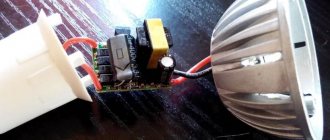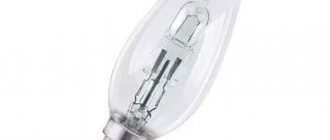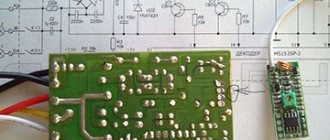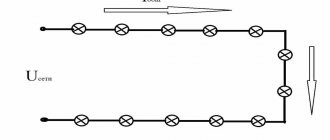Repair instructions for a table lamp.
When repairing a table lamp, we check the integrity of the electrical circuit and socket contacts - everything is as described above, but there are also some peculiarities:
Personally, I check the table lamp as follows
— I plug it into the socket, then the switch, and carefully measure with a multimeter the presence of 220 Volts at the contacts of the socket. Just be careful not to short circuit.
Note:
Energy-saving lamps can be supplied with reduced and constant voltage - take this into account when checking.
Many people are probably familiar with the situation: a table lamp breaks.
, we’ve already changed the light bulb and plugged it into a different socket - nothing helps.
It's 90% that the cause of the breakdown is burnt wires near the socket. This happens due to the fact that a light bulb of a larger, uncalculated power is often inserted.
Important:
The whole process will take you no more than an hour, provided that you already have all the supplies you need. At the same time, a cheap similar table lamp costs on average 300-500 rubles. Therefore, think again about whether you should repair it.
Well, if you still decide to repair, read on carefully.
What you need to repair a table lamp
Note:
Materials:
- two-core cable about 0.5 m long, with a cross-section of at least 2.5 m?. A meter of good two-core cable costs no more than 50 rubles.
- ceramic cartridge – 10 rub.
- electrical tape - 10 rub.
- heat-resistant insulation – 10 rub.
Tool:
- screwdrivers
- pliers (with wire cutters)
How I repaired my table lamp
I have this cute example of a Chinese green table lamp, independently decorated with little animals.
The first thing you need to do is get to the cartridge. Unscrew the lampshade fastening.
And we take out the cartridge.
As you can see, the wires were burned and torn due to strong heating, the insulation became rigid and burst.
If you have disassembled the lamp and the wires are intact, then the reason is most likely in the switch; use a multimeter or a “test screwdriver” to check the presence of voltage in the circuit before and after the switch. If there is no voltage after the switch, but there is before it, then it needs to be replaced. You can easily buy a similar switch at any electrical goods store. If there is no voltage even before the switch, then only the plug and the supply wire remain. If the plug is detachable, you can check for a broken wire. If not, we change everything along with the cable.
Important:
Unfortunately, my socket was without wire clamps. To avoid soldering, I decided to replace the cartridge. The existing wires will also no longer work, so we replace them with our own, preferably with thicker insulation. Just don’t overdo it, thick wires may not fit into the metal corrugated rod. In general, before connecting them to the cartridge, I recommend checking this. The wires at the point of connection to the cartridge must be covered with thermal insulation to avoid severe overheating.
Important:
To make it easier for the wires to fit into the corrugation, wrap the ends with electrical tape.
Since the load of the light bulb is not very large (on the lampshade it is written: “maximum 60W”), you can simply twist the wires together, wrapping them well with electrical tape.
If you have a soldering iron, you can solder it, it won’t hurt, or buy special connecting terminals. As an alternative, you can use an excellent homemade wire connection using copper tubing. Don't forget to wrap the wire connections properly with electrical tape.
Put the wires in place.
Make sure, if possible, that the wires do not lean against the socket inside the lampshade.
Well, that's it, our table lamp
working again!
Do not use bulbs larger than 60W, otherwise the wires will burn out again. This is a table lamp, not a spotlight! Well, if a 60W light bulb is not bright enough, in this case, use a gas-filled one (by the way, they say these lamps are harmful and emit toxic gas) or, better yet, an LED lamp. Such lamps heat up less, so you can safely use any brightness, they will not damage the wires, and you can also save energy.
Bright light, friends!
Our service technicians will quickly and efficiently repair lamps in Moscow. We will diagnose and repair any model of lamps: from the most ordinary wall lamps, sconces, floor lamps to luxury expensive chandeliers. The professionalism of our electricians is confirmed by a large number of perfectly completed orders!
How to repair a table lamp with your own hands?
In this article we will talk about repairing a “clothespin” type table lamp. They are very popular due to their low price and mobility. And although most of them are quite good, there is still one detail that very quickly renders the device unusable.
Lamp socket
This part is the cartridge. The fact that it is ceramic and at first glance inspires confidence is in fact just a visual illusion.
Over time, one day when it’s time to replace the lamp, you notice that it does not stay in the socket (see picture below).
The lamp does not stay in the socket
Attempts to tighten the lamp lead to nothing and it simply falls out.
Some people cannot understand what the problem is? Because when they look into the cartridge, they notice the thread and everything seems to be fine. But the lamp doesn’t want to stay in any way.
Chuck thread
In fact, the problem is in the metal “skirt” that is installed on top of the ceramic thread.
This part is made of thin metal and, most importantly, it holds very weakly. If the lamp uses an incandescent lamp, it heats up this rim very much and it can be easily removed along with it.
If you remain on the unscrewed lamp, you may not notice it at all. And when you try to install a new lamp, you will find that it falls out of the socket.
Even if you still notice that the “skirt” remains on the lamp, it will no longer be possible to install and secure it in its old place.
Metal skirt
As a result, a non-working lamp and a spoiled mood. And this problem is not limited to table lamps. Such damage also occurs in chandeliers, sconces and other lighting fixtures. And all because they all use the same Chinese cartridges. Replacing the old one with the same one will extend the life of the lamp by several months. Therefore, this option is not practical.
There is a good way to forget about this problem for a long time - replace the cartridge with a Soviet one. Of course, this will not be possible in all cases, but most often it works out.
The photo shows a table lamp with a problematic socket. The lamp falls out, no matter how hard you try to screw it in.
Table lamp
Let's move on to the repair itself.
In this lamp, you should start by removing the socket. It is secured with two screws located inside it.
Removing the lamp socket
When this can be done, or partially succeeded, we unscrew the reflector from the flexible mounting leg.
At the end of this post there is a thread, and inside the reflector, there is a base for the cartridge, which also has a thread. These two parts are used to connect the stand to the reflector.
The cord is exposed, which should be lengthened for comfortable repair. This can be done by removing the clamp at the base of the stand. A screwdriver can help with this.
Removing the clamp with a screwdriver
Next, we push the wire through one side of the corrugation and pull it out on the other.
The more wires that come out from the side of the head, the more convenient it will be to work with the cartridge.
I push the wire
We gradually pull the cartridge out of the reflector. When the cartridge reaches a sufficient length, you can inspect it.
Pulled the cartridge from the reflector
There are nuts installed on the back of the cartridge screws, so it is not always possible to unscrew them from the inside.
Nuts on the lamp socket
Now you can do it. The mounting strip is free (see picture below) and now you need to bite the wires off the socket clamps.
Removed the mounting plate
You can, of course, unscrew the clamps, but they are usually either rusty or the wire at the ends is so stiff that you still have to strip it again. Therefore, you should not waste time, but it is better to immediately bite off the wires.
I bit off the wires from the socket clamps
The ends of the wires should be carefully cleaned.
Stripped wire ends
For a replacement, you should look for a Soviet ceramic cartridge. You can find it at the market or remove it from an old chandelier or lamp. In these cartridges, the metal skirt is rolled on the inside, unlike the Chinese ones, where it is held on with glue.
When using incandescent lamps, the skirt heats up and the glue loses its properties. Hence the loss of metal threads.
Metal thread falling out
Let's disassemble the cartridge. The Chinese cartridge has two holes for mounting. Which corresponds to the holes on the bar.
Disassembling the cartridge
In the Soviet version, there is only one hole, and it is located exactly in the middle. Therefore, you need to do the same on the bar, between the two existing ones.
Hole in the middle of the bar
The diameter of the drill used should not be too large. Suitable for 4 - 4.2 mm. We drill a hole and remove burrs on it with a file.
Drilled a hole
Using a 4 mm screw, press the cartridge to the bar.
Pressed the cartridge to the bar with a screw
If the screw is too long, bite off the excess with pliers, otherwise it will rest against the bottom of the reflector.
“Bite off” the extra part of the screw
Now we insert the prepared cord into the hole in the bar. And then, into the cartridge.
I put the cord through
We make loops for the clamping screws of the cartridge. The hinges should be screwed in the direction of the screw clamp. Otherwise, the wire strands may spread out to the sides.
Loops for chuck clamping screws
Screw hinges
We fasten the loops and assemble the cartridge.
Fastening the loops
Next, we pull the excess wire back through the base of the “clothespin” until the bar with the socket completely fits into the head of the lamp.
Pulling out the extra wire
We combine the hole in the strip with the hole in the reflector and the thread on the corrugation.
Combination
We twist the headband clockwise until it stops.
Tightened the headband
There should be no gap left between the two parts. The cartridge became almost in the middle of the reflector.
The cartridge is installed
We screw in the lamp and check the operation of the lamp. The photo below shows that the lamp works great.
Refurbished table lamp
It should be noted that in such small-sized lamps, it is better to use LED lamps. Thus, the lamp itself will not heat up and energy savings will be much higher. Moreover, LED lamps have small bulb sizes. This will help hide its body in the reflector, which will eliminate side light.
Reasons for repairing LED lamps: device, electrical circuits
Before you start repairing LED lamps with your own hands, it is important to find out the reasons for their failure. The declared service life of lamps may not coincide with the actual lifespan
This is due to poor quality crystals.
There are the following reasons for malfunctions of lighting devices:
- Voltage drops do not greatly affect the operation of electrical parts; noticeable fluctuations in voltage readings can cause a malfunction;
- unsuitable lamp. If the wrong lamp is selected, the light source may overheat.
- light-emitting elements of poor quality contribute to the rapid failure of products;
- improper installation of the lighting system has a negative impact on electrical wiring;
- Strong vibrations and shocks can cause damage to such equipment.
Disassembling the device allows you to determine the exact causes of breakdowns
To avoid having to repair the LED light bulb yourself, you need to minimize the impact of the listed factors on the lamp.
Frequent problems arising with ice devices
It is often necessary to repair LED lamps yourself if there are problems with the capacitor. To carry out the test, it will have to be removed from the board. You can measure the voltage of an element with a multimeter. The same device checks the operating condition of the diodes.
The diagram shows the order of connecting drivers
In some cases, LED elements blink. This happens if the current-limiting capacitor is faulty. The cause of the breakdown may be a burnt-out emitter. The malfunction cannot be seen in all LEDs, so you will have to check every detail. A tester is used to find the problematic diode.
When making renovations, you can experiment with LED elements. For example, choose warm or cold light temperatures. Some devices do not have a smoothing capacitor and a rectifier. They can be installed using a soldering iron.
Lighting sources are tested using a multimeter or probe
What do we need to repair LED lamps?
You don't need any complicated tools to repair an LED lamp:
- Soldering iron. Soldering irons with a thin tip are preferred.
- Solder and rosin (you can also use flux or soldering acid, depending on what you have on hand).
- Tweezers. Since the parts cannot be touched by hand, this tool will definitely be useful.
- Holder. Instead, you can use an assistant to hold the rosin board while soldering.
- Gas-burner. Thanks to it, you can very quickly unsolder a broken part and then solder a new one. You can buy it at any tobacco store. However, you don’t have to spend money on a burner and use a regular turbo lighter.
- "Donor". This could be another broken light bulb. You can remove the necessary parts from it and put them in another lamp. You can use an LED light bulb as a donor, which can no longer be repaired.
- Super glue. You will need it after repair to glue the lampshade in place.
Service life of a repaired lamp
How long will such a light bulb with a “shunted” LED last?
Everything will depend on two factors. Firstly, what is the voltage in your network (normal, high (>230V) or low).
Secondly, where is this light bulb located? If this is a corridor, toilet, utility room, barn, etc., where it is turned on for a short time, then the lamp can easily last for several months.
If this is a living room, bedroom, kitchen, then we are talking about a much shorter period.
It is believed that the missing element will cause an increase in current in the entire circuit. Which is often what actually happens.
And this already leads to the sequential failure of the remaining LEDs one after another.
But if the driver in the lamp is made of high quality and has a good pulse current stabilizer, then the operation of the lamp will be maintained for a very long time.
Here is a visual comparison of the current strength in a “shunted” lamp...
and in a lamp, where instead of a burnt-out LED, several additional resistors were soldered in, which were precisely supposed to reduce the current.
As you can see, there is practically no difference. Do you think it’s worth bothering with this and worrying about a shorter service life?
But again, we repeat, this is only if you have a good driver.
With the classic cheap power supply circuit for an LED lamp using a quenching capacitor, the service life is reduced significantly.
Current stabilization in such lamps is very conditional.
Connecting wires to the cartridge and the final stage of repair
After the operation of removing the contact petals from the socket is completed, you can begin connecting the wires to the socket and assembling the lamp into a single unit. We thread the wire into the mounting bracket of the socket, remove the insulation from the conductors and form “rings” on them.
Next, using M3 screws, we connect the wires to the contact elements of the cartridge.
As you can see, the center contact screw not only makes electrical contact with the center blade, but also secures it in the socket.
Well, the last thing to do is to attach the cup of the table lamp to the corrugated pipe and thereby secure the socket with the wire. To do this, just align the corrugated pipe and the electric cartridge with the mounting holes of the cup and screw in two screws.
That's it, the entire DIY table lamp repair is complete. We admire the result.
I hope this material will be useful to the home handyman
Thank you for attention. All the best
And finally, just a very funny video about electrics:
We recommend that you read:
Author - Anton Pisarev
- https://vashtehnik.ru/elektrika/remont-svoimi-rukami-svetilnikov-i-lyustr.html
- https://sekret-mastera.ru/vtoraya_zhizn/remont-nastolnoj-lampy.html
- https://moydomik.info/load/remont/remont_ehlektriki/remont_nastolnoj_lampy_svoimi_rukami/29-1-0-138
Powerful light bulb - for repair
If your table lamp is designed for the use of ordinary incandescent light bulbs with an E27 base (approximately the same as in the photo above), repairing such a table lamp with your own hands will be the easiest - you can do it in an hour.
In the case of repairing a table fluorescent lamp, it may take a little more time - read more about such repairs at the very end of this article. In the case of conventional table lamps, the most common cause of their breakdowns is burnt wires near the socket - due to the use of incandescent light bulbs of higher power than those for which the lamp is actually designed.
You cannot use light bulbs with a power of more than 60 W in table lamps! It is best to use low-power LED bulbs in such lamps, for example 3-4 W - the light from them will be the same, and the savings and safety are obvious!
Be careful with the lamp - if it suddenly breaks, and you do not yet know the reason, do not touch its metal parts while it is connected to the mains!
All operations involving inspection of the lamp and its repair can be carried out only after the lamp plug is removed from the socket. Why? Yes, because burnt wires can touch the metal lamp shade and if you accidentally touch the metal, you can easily get an electric shock!
Repairing or replacing a lamp socket or chandelier
Let's say the cartridge crumbles or the contacts are so rusty that there is no point in cleaning them. In this case, it is recommended to replace the cartridge. The photo shows options for purchased electrics:
Disassembling the lamp
In front of us lies a typical white ceramic flat mount socket (left). Structurally becomes part of a bathroom wall lamp
Note the relatively strong isolation of the node. If necessary, such a cartridge can be purchased for a price of 30 rubles and replaced with the old one. Black sockets are also structurally included in the inclined type lamp, but for the pantry
It is not forbidden to install one under the ceiling of the bathroom, but if the neighbors flood it, such an installation will not lead to anything good. Notice the design on the right. Inclined chuck without back wall. We found a chandelier backdrop and showed that the parts fit together perfectly. It is not necessary to buy the cartridge separately; purchase it as part of the electrical part of the lamps. In stores, instead of the usual black cartridges, readers will be surprised to find mostly white ones - plastic and ceramic. In terms of size and design, they were not close to the usual ones. When modifying the socket of a chandelier or lamp, the work will increase: usually the backdrop is attached to a threaded connection (seen in the photo), which does not fit the diameter of the new standards. You will have to finish it with a file, which is long, tedious and does not guarantee a successful outcome. Our technical solution looks better, although the inclined lamp is a little more expensive than the socket separately.
Types of cartridges
It can be useful to clean the cartridge contacts. Do this with fine sandpaper. The procedure is aimed at reducing contact resistance. In this case, ignition is simplified
Please note that halogen lamps often blink several times before starting. This does not indicate the need to repair the lamp, but simply indicates the design features of gas-discharge sources
Useful tips
Some practical tips for lamp repair:
- Do not put pressure on the light bulb when screwing it into the socket. The base is made of ductile metal that deforms under pressure. However, halogen bulbs have circular contacts, so they are difficult to damage.
- Halogen lamps rotate endlessly. From a certain moment, when rotating, the glass begins to scroll relative to the base. The problem is the contacts. The new lamps have a shorter thread and do not reach the bottom.
- If the switch is in the off position, the phase should not be directed to the cartridge contacts. If this is not the case, you need to turn off the circuit breaker in the electrical panel (at the entrance).
To create contact between the lamp and the base, perform the following steps:
The central contact is turned upward using a screwdriver. The contact pad should be at an angle, not vertical. The lunar contact is usually vertical
Any of the existing petals is carefully lifted (at least a millimeter), focusing towards the periphery of the cartridge. The bent ends are slightly straightened.
Most often, two or three fittings are enough for the lamp to turn on.
Particular attention should be paid to maintaining the edges of the cartridge, otherwise it will have to be replaced
Source
Diagnosis of failure
Since no one keeps any special tools for diagnosing a printer at home, you will have to rely only on a visual inspection of the device.
Often, the problem that arises is solved during the inspection process:
Pay attention to the error number, which is written on the computer monitor screen, and in some printer models it is duplicated on its own screen (you will also need this information when talking to the service technician if you can’t handle it yourself); If there is no error on the monitors, then check whether the printer is connected to the computer and whether it is connected to the network (we are all human and sometimes we forget about basic things); If everything is in order with the power supply, then you should proceed with an internal visual inspection for paper stuck inside the printer mechanisms (if the cause of the breakdown is paper, then disconnect the cartridge and carefully remove the stuck piece); Check all mechanisms, whether the paper feed tray is tightly closed, whether the tray carriage is slammed shut; niches and cavities for contamination; dust, dirt, and ink from the printer itself can clog its mechanisms and cause breakdown. During a visual inspection, check all niches and cavities for contamination with dust, dirt, or dried ink. Very often, dried ink accumulates on the ink head or on adjacent working units
If you manage to discover any of the above, rest assured that you can handle cleaning them yourself.
Reasons for writing off a table lamp in the write-off act
As of today, reconciliation reports are available. Checking compliance with cash, payment and financial discipline Cash transactions for the period The cash desk premises in the Institution are isolated and equipped.
A complete check of cash transactions established that the funds received from the bank were capitalized in full and on time. WATCH THE VIDEO ON THE TOPIC: We draw up an act for writing off materials Household inventory on the balance sheet Independent choice of a specialist Causes and signs of breakdowns Regardless of how long ago the lamp was purchased and how long it worked, one fine day it may fail.
In such a situation, a reasonable question arises: why did this happen and how to solve the problem? There may be several factors that lead to various types of malfunctions: Inoperative cartridge. Replacing it with a new one will not be particularly difficult; you don’t even have to call a specialist.
But if you need to replace not only the cartridge, but also the wires connected to it, you cannot do without the help of a qualified technician. Burnt twist. In low-quality lamps, both phase and zero twisting can burn out.
In both cases, the lamp will not perform its function.
The problem is corrected by removing the failed twist, stripping the wires, and restoring them by soldering.
The soldering area must be protected with insulating tape or other materials.
Defect in the transformer or power supply. Halogen and LED lighting devices are most often susceptible to such damage. The power supply and transformer in these lamps usually do not last long, so sooner or later they will have to be updated. Bad signal from the remote control. Lamps equipped with remote controls often stop working.
In some cases, simply replacing the remote control is enough to restore operation. Problems with the light bulb. Sometimes, in order to resume the operation of a light fixture, it is enough to check whether the bulb has burned out and how well it is screwed into the socket.
What problems may arise
To figure out why the LED strip does not light up, you need to know about the possible causes of the malfunction, they are as follows:
The backlight does not turn on completely. In this case, first you should check whether the power supply is turned on. The next step is to check the voltage at the outlet. A multimeter or test lamp is suitable for this. If everything is in order, you should check the wire that leads the voltage to the power supply
If there are no problems, you should pay attention to the quality of the connection between the contact pad of the tape and the wire. Also, the cause of the malfunction may be hidden in the printed circuit board; the diodes lit up only up to the center of the tape
the diodes lit up only up to the center of the tape
The cause of this malfunction is the burnout of one of the segments;
LEDs flicker constantly. There may be several reasons for this. One of them is the failure of the power supply. It is also recommended to check the connections along the entire length and the wires feeding it. Sometimes flickering occurs due to overheating or the gradual expiration of the life of the diodes; soon they will stop lighting up altogether;
a separate piece of tape or some diodes flicker. This occurs due to damage or burnout of one of the chips. The resistor may also be faulty.
LED strip does not light up halfway
This breakdown is one of the most common. This indicates that the track has failed in one of the segments. Diagnostics consists of applying power to areas that are located behind the problem area of the LED strip. Don't rush to blame diodes for a breakdown. Sometimes this happens due to a break in the conductor. To prevent this from happening, the bends should not be too sharp.
An example of a break on a bend.
To eliminate this malfunction, the non-working section must be removed and the working parts soldered together. This repair option is not always appropriate, since the tape will become shorter. In any case, you will have to buy another product to fill the gap.
Lost brightness
The loss of brightness may not be immediately noticeable. The ribbon will continue to glow, but not as brightly as before. This can happen with a single section or along the entire length. Possible reasons are:
- The LEDs are reaching the end of their service life. If the diodes stop shining as before after 2-3 months, this indicates a defect that occurred in production. Also, gradual attenuation may indicate overheating;
- power supply failure. It is also recommended to check the contacts where the tape connects to the power source. If a plug-socket pair or connector was used at the junction, oxidation may have occurred, causing current conduction to be impaired in these areas.
Dimmed LEDs.
To figure out how to fix an LED strip that has stopped shining brightly, experts advise first to determine the degree of stability of its operation. It is worth starting to repair the power supply if all the diodes have dimmed. If the brightness is impaired in a particular area, it will have to be replaced.
There's no light at all
If every single diode does not light up, you should look for the cause in the power supply. First you need to check the 12-volt adapter and the presence of the 220-volt voltage itself. The problem may occur at the low voltage output and input. In most cases, the cause of this is a poor connection in the area with the first three chips. To find out, power should be supplied from the following diodes in order. If the backlight is turned on, the problem area is cut off along a special line.
Line for removing the damaged section.
Flashing
Flashing LEDs may indicate insufficient adapter power. To prevent this from happening, each source must have a power reserve of at least 20%. In addition, soldering that was performed with aggressive types of flux can cause flickering. When connecting individual sections, it is recommended to use regular rosin or immediately neutralize the flux that remains on the substrate.
Recommended rosin for soldering.
If the product operates on a 220 V network, there is a possibility that the smoothing capacitor has failed. In this case, the flickering will be almost invisible. The most harmless reasons for blinking LEDs are a breakdown of the control panel, problems on a segment of three chips, or exhaustion of diode resources.
The simplest electrical circuit
To repair lighting devices, you need to know at least the general principles of constructing electrical circuits. Modern lamps are equipped with many additional electronic mechanisms and have a variety of functionality. However, the principle of connecting a lighting device (light bulb) almost always remains the same.
The simplest electrical circuit of a lamp.
The figure shows diagrams of different types of lamps with several light sources, but they are also typical for table lamps.
An important feature, especially for desktop models, is the ability to adjust the brightness and intensity of lighting. It is these devices that are widely used for students, creative workers and in the electronics industry for the assembly of small parts and precision mechanisms.
In such models, the electrical circuits are somewhat more complex and include additional elements for adjusting the lighting.
Brightness control circuit, where S2, S3, S4 are step controllers.
Stated characteristics
3-stage brightness adjustment Touch switch Powered by USB port Minimum mode: 12 hours Medium mode: 10 hours Maximum mode: 8 hours Input: DC 5V / 500MA Power: <1.6W = Brightness: 650LX Base size: 113 x 100 x 28 mm Height: 30 cm Cable length: 95 cm White color, Weight: 182 g The lamp has a comfortable flexible leg
Height to top 36 cm
It shines with white light, without blue. Photos were taken in complete darkness at maximum mode
Compared to Xiaomi USB Lamp, which has a warm white tint
They are comparable in brightness. In general, I liked it in use, it’s a convenient and useful thing for the home. There are also disadvantages, of course. There is a round charging connector and a specialized cord (micro USB would be better), there are no indicators of charging or remaining capacity.
They obviously lied about 8 hours at maximum; I didn’t measure exactly how long, but after a few hours a significant decrease in brightness was already noticeable. I was also alarmed by the phrase from the instructions and the product page that if it is not used, then in order not to kill the battery by overdischarging, you need to charge it for 8 hours at least once every 2 months. Well, of course, touch activation, the board consumes power... I thought, did the Chinese really put a lithium can without any protection at all?? And the operating time... It would be necessary to replace the can. So I decided to take it apart.
Connection diagram, startup
The ballast is connected on one side to the power source, on the other to the lighting element. It is necessary to provide for the possibility of installing and fastening electronic ballasts. The connection is made in accordance with the polarity of the wires. If you plan to install two lamps via ballasts, a parallel connection option is used.
The diagram will look like this:
A group of gas-discharge fluorescent lamps cannot operate normally without a ballast. Its electronic design ensures a soft, but at the same time almost instantaneous start-up of the light source, which further extends its service life.
Ignition and maintenance of the lamp's functioning is carried out in three stages: heating of the electrodes, the appearance of radiation as a result of a high-voltage pulse, maintenance of combustion is carried out by constantly applying a small voltage.
Failure detection and repair work
If there are problems with the operation of gas-discharge lamps (flickering, lack of glow), you can make repairs yourself. But first you need to understand whether the problem is in the ballast or the lighting element. To check the functionality of the electronic ballasts, the linear light bulb is removed from the luminaires, the electrodes are short-circuited, and a regular incandescent lamp is connected. If it lights up, the problem is not with the ballast.
Otherwise, you need to look for the cause of the failure inside the ballast. To determine the malfunction of fluorescent lamps, it is necessary to “ring” all the elements in turn. You should start with the fuse. If one of the circuit components fails, it must be replaced with an analogue. The parameters can be seen on the burnt element. Repairing ballasts for gas-discharge lamps requires the use of soldering iron skills.
If everything is in order with the fuse, then you should check for serviceability of the capacitor and diodes that are installed in close proximity to it. The capacitor voltage should not fall below a certain threshold (this value varies for different elements). If all the ballast elements are in working order, without visible damage, and the ringing also did not give anything, all that remains is to check the inductor winding.
Repair of compact fluorescent lamps is carried out according to a similar principle: first, the housing is disassembled; The filaments are checked and the cause of the breakdown on the control gear board is determined. There are often situations when the ballast is fully operational, but the filaments are burned out. Repairing the lamp in this case is difficult. If there is another broken light source of a similar model in the house, but with an intact filament, you can combine the two products into one.
Delicate lilies: lampshade decoupage
The next step will be to carefully treat small cracks and irregularities with this paste. After sanding, we will apply two layers of paint, and after drying our lampshade will be ready for decoration.
Preparing napkins and decoupage
Attention! You can first cut out the motifs, then separate the layers and only then iron them. Choose the option that is convenient for you.
What kind of lighting do you prefer?
Built-in Chandelier
Gradually cover the entire surface or part of it with motifs, in accordance with your idea. Depending on the motive, the design must be combined in whole or in part. Some patterns do not require a match.
Final touches
Look at the resulting drawing: perhaps it requires some element to be completed. In this case, I used a simple pencil to mark the flowers that were on a light background. The varnish will be a layer of transparent wallpaper glue. It dries in a couple of hours. To finish the bottom of the lamp, I used gray braid that matched the style. I fix it with a few drops of glue from a glue gun.
As a final chord, I place textile flowers at the junction. So, now you can remove the protective coating from the lamp leg, wipe it with flannel and take the final photo.
Application
List of materials needed for this work: 1. Lampshade. 2. Primer or putty with the indication: “for decorative coating.” 3. Sandpaper. 4. Brushes. 5. Watercolor paints. 6. Waterproof white paint. 7. Napkins with matching motifs. 8. Braid. 9. Scissors. 10. Glue gun. 11. Scotch tape.
Expert opinion
It-Technology, Electrical power and electronics specialist
Ask questions to the “Specialist for modernization of energy generation systems”
Malfunctions of lamps with fluorescent lamps and their repair » Website for electricians - articles, tips, examples, diagrams A new fabric lampshade needs to be sewn with the seam forward with a needle and put on the old base, it is better to secure it at the top and bottom with polymer glue. Ask, I'm in touch!
Diagnostics of an electric motor or how to identify a malfunction of the stator and rotor
If there is a suspicion of malfunctioning of the electric motor, then the exact breakdown can be identified using diagnostic measures. To do this, you will need a multimeter, as well as a diagnosable rotor and stator. First, let's find out how to check the suitability of the rotor (aka anchor):
- Carry out a visual inspection. If there are signs of soot and deformation, then there is a high probability that the part has burned out. It is also necessary to inspect the collector unit, on which the presence of soot, chips and distortions is unacceptable. Misalignment occurs when the brushes wear unevenly.
- Use a multimeter to measure the resistance of the armature winding. Set the device to 200 Ohm resistance measurement mode or continuity testing
- One probe should alternately touch the collector plates, and the second should touch the steel core. The presence of resistance indicates a violation of the insulation. To eliminate the problem, you will need to replace the rotor winding
- If a breakdown between the winding and the housing is excluded, then the rotor must be checked for signs of insulation failure. To do this, use a multimeter in resistance measurement mode to check the quality of the insulation between the plates. A mark is placed with a marker from the beginning, and after that the resistance between the plates is checked one by one
- The resistance value should be approximately the same. A difference in resistance value of more than 10% from the standard value indicates an insulation failure. You will need to rewind the rotor winding or replace the part completely
- Interturn short circuit - another cause of failure may be the presence of an interturn short circuit. However, it is impossible to check the presence of such a defect with a multimeter. To do this, a special device is used, which must be guided through the collector. If there is an interturn short circuit, the device will make a corresponding sound. The defect can be eliminated by replacing the winding
If it is determined that the defect is with the armature, then it must be rewound or replaced. If the rotor is working properly, then we move on to checking the serviceability of the stator - a stationary mechanism, which also consists of a winding and a steel core from a set of thin plates.
The algorithm for checking the health of the stator is as follows:
- The absence of breakdown of the winding to the housing is checked. To do this, touch the winding terminal with one probe, and the steel core with the second. The device should not show the resistance value, otherwise a breakdown may occur and the stator must be rewinded
- The resistance in the windings is checked by touching its terminals one by one. The resistance value in all windings should be approximately the same value, which indicates its serviceability
- Check the integrity of the metal plates of the steel core. It is unacceptable for them to delaminate, so you will need to replace a separate unit
It doesn’t matter what brand the jigsaw is - Interskol, Makita, Bosch, Skill, Metabo and others. When purchasing a new motor, you need to take into account its parameters and dimensions. There are markings on the motors that you need to use when purchasing a new electric motor for a jigsaw.
This is interesting!
It is almost impossible to repair the electric jigsaw motor yourself, since this will require rewinding the winding. This can be done at a service center, but the cost of such a service is almost identical to the price of a new part.
Causes of light bulb failure
Before repairing the lamp, it must be disassembled to determine the cause of the breakdown.
The best way to solve a problem is to take systematic action. Therefore, we will carry out the work in a clear sequence:
- We prepare a set of tools.
- We dismantle the lamp.
- We look for and fix problems.
- Reassemble the lamp in reverse order.
To perform the repair you will need the following tools:
- flat screwdriver;
- multimeter;
- a 25–30 W soldering iron, as well as a soldering kit.
We carry out dismantling in this order:
First we detach the flask from the base
The operation should be performed with extreme caution to maintain the integrity of the base. The parts of the light bulb are joined together with latches
To disassemble the device, it is recommended to use a screwdriver with a thin but wide blade. One of the latches is usually located where the technical data of the light bulb is indicated. We point the screwdriver into the gap and gently turn the halves apart. Next, we move the screwdriver in a circle until the lamp is divided into two parts, and then we unfasten the base and bulb. Disconnect the wires going to the filaments. Two pairs of wires are attached to the bulb (they are filaments), to test for serviceability, they need to be disconnected. The threads are usually not soldered, but wound on wire pins in several turns. In this regard, detaching the threads is usually not difficult. We check the lamp filaments for functionality. The flask most often contains a pair of spirals with a resistance of 10–15 ohms. We check using a multimeter. If the threads are not damaged, then the problem most likely lies in the ballast. And vice versa: if the threads are damaged, the ballast is operational.
Causes of breakdowns
It often happens that table lamps simply stop turning on and working. There are several main reasons for these malfunctions:
- Broken cord. This may be indicated by periodic loss of light or blinking. Very often the main place of damage is near the fork, as it is susceptible to frequent bending.
- Failure of the switch will not allow the circuit to close, which will cause the absence of light.
- Broken wiring near the socket. Very often this occurs due to burnout of contacts that fall out of the clamps.
Diagnosing this is quite simple, which can be done with a routine visual inspection or using special instruments.
How to repair a lamp
You screwed a new lamp into the socket, but it does not light. The reason for this may be that contact 1 of the cartridge is not bent enough (Fig. 1) .
You can correct the position with a screwdriver.
Here's another example. The lamp goes out and comes on at the slightest movement. This is a sign of a broken cord. Table lamps, floor lamps and other electrical appliances (irons, stoves, electric shavers), which we connect to the network and often move, usually have flexible cords. But in those places where the bend of the cord is the steepest, the wire still gradually frays. To avoid this, install special rubber or plastic bushings 4, elastic spirals, and put on flexible tubes (Fig. 3). The easiest way to correct the defect is to cut out the “sore” spot from the cord. If this does not suit you and you decide to use a new wire, try to buy one so that the cross-section is no smaller than the old one. Failure to comply with this rule may result in a fire.
It would seem simple to install a new wire in a table lamp. But there are some tricks to this matter. Sometimes it depends on them whether the lamp will last for many years after repair or whether a new repair will be required in a month. In the socket, the wire is clamped with screws 2 (Fig. 1) and then goes to switch 1 (Fig. 2). The illustration shows a push-button switch located in a stand, but it can also be located on a wire. How to strip the wire? We do not recommend using wire cutters or knives: you can damage individual conductors, and this will affect the reliability of the connection. In factory conditions, there is a special tool for stripping wires, but we recommend removing the insulation with a soldering iron. At the ends of the wire going under the screws of the plug, it is necessary to make rings 2 (Fig. 3) . It is advisable to solder them. As a flux, use rosin or solder paste, sold in burs with a soldering iron. Many types of plugs have a bracket 3 that holds the wire in the plug. If the diameter of the wire is too small and the bracket holds it weakly, put a piece of rubber tube 4 on it. It will simultaneously strengthen the wire in this “weak” place.
Recently, a connecting wire made of rubber or plastic, molded integrally with the plug, has appeared on sale. It is reliable, inexpensive, and can be used to repair a wide variety of electrical appliances.
The cause of a malfunction of an electrical appliance may be a failure of the switch. Modern push-button switches, as a rule, have a sealed housing that is not suitable for disassembly. Therefore, they are not repaired, but replaced with new ones.
The most important thing when connecting chandeliers is to know where to connect which end of the wire. Therefore, we present a diagram for connecting the chandelier to the network (Fig. 4).
In practice, I never think about which end of a chandelier is which. It usually looks like this: there are 3 ends sticking out from the ceiling and 3 ends from the chandelier. We connect the ends one to one on a temporary structure. We click the double switch. If in any position the lamps are burning at full intensity, we throw any two ends on the chandelier and connect them permanently. Everything will work fine.
The plastic nut that secures a lampshade with a small internal diameter in a chandelier can be difficult to unscrew. I use wooden clothes tongs for this.
Before unscrewing a light bulb that is stuck to the socket, place a plastic bag over it. Even if the light bulb bursts from excessive force, the fragments will remain in the bag.
And further. In electrical work, copper and aluminum wires should not be twisted. An electron pair is formed between these metals, which contributes to the destruction of the contact. Such things are connected through a screw with a nut, and a steel washer must be placed between them.
There are special connecting blocks in stores that screw the wires through the bushing with screws.
Wiring diagram for Chinese touch switch
So how do the wires connect to this miracle box? First of all, focus on the inscriptions and symbols on the case.
One of the power wires must be interrupted by a switch. Because of this, the lamp actually does not light up.
In this case, it does not matter which wire it is: phase or neutral. After all, as soon as you insert the other side of the plug into the socket, the “timings” will immediately change
In general, connect the conditional phase cable from the power cable to the voltage supply cable to the sensor (black - black).
Connect the neutral from the network to the other power wire of the sensor - red (red). That is, the red and black wires from the box go to the 220V outlet.
White (white) and again black (black) are connected by two wires going to the lamp.
According to the diagram, you need to connect the three ends in one place:
conditional zero from the network
ZERO for sensor
ZERO on the light bulb
The phase is interrupted through the sensor and goes to the lamp with a separate conductor. If you're completely confused, here's a clearer picture.
The general connection diagram is as follows.
After twisting the wires, all contacts must be soldered.
And then wrap it with electrical tape or apply heat shrink.
Everything can be connected to PPE (insulating plugs).
Repair cost, warranty
You pay for the work only after a positive result. We always perform our duties efficiently and make sure that there are no errors in our work. We work so that our clients can enjoy the results!
| price | ||
| PC. | Disassembly and assembly of the lighting fixture | 400 |
| PC | Replacing lamps | 150 |
| PC. | Replacing lampshades | 150 |
| PC. | Cleaning the horn from burnt wiring | 350 |
| PC. | Replacing a button, switch (sconce, floor lamp) | 350 |
| PC. | Replacing the light controller (Dimmer) | 450 |
| PC. | Replacing wiring in a fluorescent lamp | 550 |
| PC. | Replacing the starter socket | 250 |
| PC. | Replacing a round chandelier transformer | 1000 |
| PC. | Replacing a chandelier transformer, lamp | 500 |
| PC. | Diagnostics of the lighting device | 800 |
| PC. | Replacing wiring in a floor lamp | 450 |
| PC. | Replacing wiring in a chandelier, sconce | 300 |
| PC. | Replacing a non-standard cartridge | 300 |
| PC. | Replacing a conventional cartridge | 200 |
| PC. | Replacing the throttle | 500 |
| PC. | Replacing the wiring in the horn | 300 |
How does our company approach the repair of floor lamps and sconces?
You need to call us at the numbers listed on the website and ask the consultant everything you need: cost of services, operating hours, speed of order fulfillment, and so on. Or immediately bring your floor lamp or sconce to our workshop. Our employees fulfill orders within the agreed period.
Type Diagnostics Master's work
Floor lamp or sconce 350 rub. from 1500 rub.
We also have our own warehouse of lighting elements; if you wish, we can provide spare parts and lamps for your lamp.
Tell me what doesn't work
Address of the service center in the Northern Administrative District: Moscow, Khoroshevskoe highway, 24. Begovaya metro station, 2 minutes on foot.
Bottom line
In this article, we examined in detail the typical malfunctions of monitors and their self-repair with examples.
Repair cost
The cost of repairs depends on the availability of parts and their cost. Service centers can charge from 500 rubles for work. A warranty is added to this price, which is usually from 1 month.
When repairs are not cost-effective
If the matrix is broken, repair is not profitable. Its cost starts from 70% of the cost of the entire monitor.
Useful videos on repairs
Post Views: 1,882










